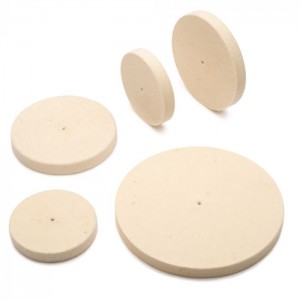The wool felt wheel industry is undergoing a significant transformation in its supply chains, driven by factors such as global market dynamics, technological advancements, and the need for greater resilience. As the demand for wool felt wheels continues to rise across various industries, companies are reevaluating and restructuring their supply chain strategies to ensure a stable and efficient flow of products from raw material sourcing to end – user delivery.
One of the key changes in the wool felt wheel supply chain is the focus on raw material sourcing. Wool, the primary material for wool felt wheels, is sourced from various regions around the world. In recent years, there has been an increasing emphasis on sustainable and ethical sourcing practices. Companies are now working closely with wool producers to ensure that the wool used in their products is obtained from farms that adhere to environmental and animal welfare standards. This not only helps to meet the growing consumer demand for sustainable products but also ensures a stable supply of high – quality raw materials. Additionally, some companies are exploring alternative sources of wool or developing synthetic blends to reduce their dependence on traditional wool supplies and mitigate the risks associated with fluctuations in raw material availability.
Technological advancements are also playing a crucial role in transforming the wool felt wheel supply chain. Automation and digitalization are being introduced at various stages, from manufacturing to inventory management and logistics. In the manufacturing process, automated machinery is being used to produce wool felt wheels with greater precision and efficiency. This reduces production costs, improves product quality, and allows for faster turnaround times. Digital inventory management systems are being implemented to track stock levels in real – time, ensuring that companies can quickly respond to changes in demand and avoid stockouts or overstocking. Logistics operations are also being optimized through the use of advanced tracking technologies and route – planning software, enabling more efficient transportation of wool felt wheels from manufacturers to distributors and end – users.
Another important aspect of the supply chain transformation is the strengthening of partnerships and collaborations. Wool felt wheel manufacturers are forming strategic alliances with suppliers, distributors, and even competitors to share resources, knowledge, and risks. For example, manufacturers may collaborate with logistics companies to develop more efficient shipping solutions or partner with research institutions to improve product quality and develop new products. These partnerships not only enhance the competitiveness of individual companies but also contribute to the overall resilience of the wool felt wheel supply chain.
In the face of global challenges such as trade disputes, natural disasters, and pandemics, the wool felt wheel industry is also focusing on building more resilient supply chains. This involves diversifying suppliers, creating contingency plans, and improving supply chain visibility. By having multiple suppliers in different regions, companies can reduce the impact of disruptions in any one area. Contingency plans are being developed to address potential risks, such as raw material shortages or transportation disruptions. And with increased supply chain visibility through the use of digital technologies, companies can quickly identify and respond to any issues that may arise, ensuring the continuity of their operations.
As the wool felt wheel industry continues to evolve, the transformation of its supply chains will be an ongoing process. By embracing sustainable sourcing, leveraging technological advancements, strengthening partnerships, and building resilience, the industry can ensure a stable and prosperous future, meeting the growing demands of customers while navigating the challenges of a complex global marketplace.

Post time: Jun-09-2025
